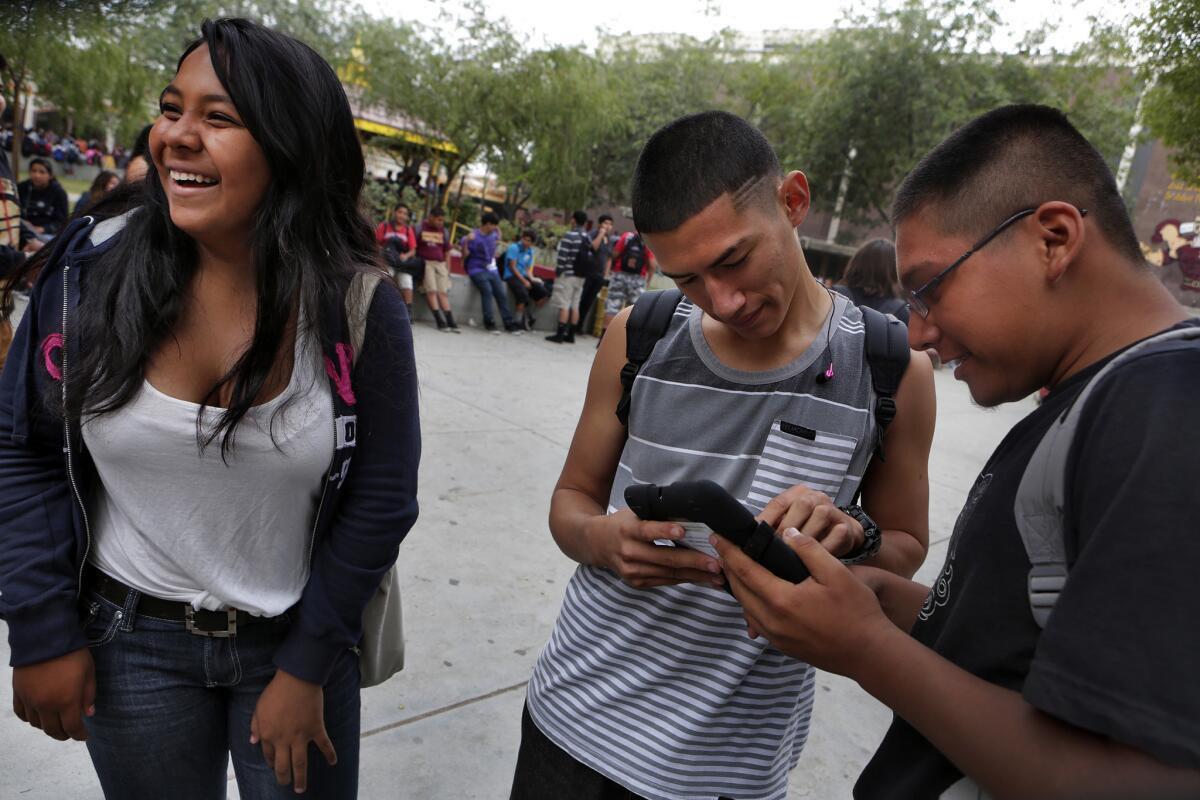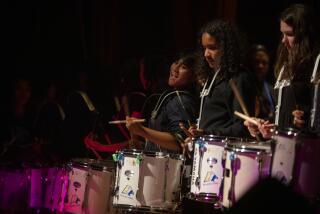L.A. Unified to get $6.4 million in settlement over iPad software

Students at Roosevelt High School in Los Angeles try out their iPads with Pearson software in 2013.
The Los Angeles Unified School District has reached a tentative $6.4-million settlement over curriculum from education software giant Pearson that the school system said its teachers barely used.
The pact is the latest fallout from an aborted $1.3-billion plan to provide an iPad to every student, teacher and campus administrator in the nation’s second-largest school district.
The Board of Education is expected to vote on the settlement in October. The bidding process that led to the original contract is the subject of an FBI investigation.
Under that contract, Apple agreed to provide iPads to L.A. Unified while Pearson provided curriculum on the devices as a subcontractor. As a result, the settlement was with Apple, even though the dispute concerned the Pearson product.
Under the agreement, Apple will pay the district $4.2 million. Another computer company, Lenovo, also had charged the district for Pearson curriculum. The district won’t have to pay $2.2 million for laptops recently purchased, according to the settlement.
“That amount of money doesn’t make up for the damage to the district’s reputation or compensate for the amount of time lost by students and educators in this misbegotten project,” said Scott Folsom, a member of the independent committee that oversees school modernization and construction bonds.
The deal avoids protracted, costly legal wrangling with Apple and Pearson.
L.A. Unified bought more than 40,000 iPads with the Pearson curriculum at a cost of $768 apiece. The district used bond funds to make the purchases.
Nearly all the money from the settlement will be used to buy computers through a competitive district grant program.
“There are many schools that have not received devices, but that nonetheless have a need for instructional technology and innovative ideas for how to use it,” said Supt. Ramon C. Cortines in a memo this week to the Board of Education. “The $6.4 million in proceeds represents an exciting opportunity to invest in such schools and to promote collaboration among campuses.”
The deal with Apple, reached in June 2013, was part of a bold initiative — and an exclusive deal with the company — to use school bonds to pay for industry-leading tablets. The deal with Lenovo came later, after the district decided to include devices from other manufacturers and to slow down a technology rollout that was beset with problems.
At the time of the pact with Apple, Pearson was supposed to provide all the math and English curriculum for the school system. The contract with Apple included a three-year license for the Pearson curriculum that added about $200 to the cost of each computer.
During the first year of the license, Pearson provided only sample units of curriculum, rather than a finished product. The contract allowed for the partial curriculum.
Teachers received limited training on the devices. The district later accused Pearson of providing an underwhelming product beset by technical glitches. Consultants concluded that few teachers even used the Pearson software.
Pearson has defended the quality of its work, noting that other school systems continue to use its online courses.
The district had threatened to sue over the Apple/Pearson contract. A district spokesman on Friday praised the work of all involved in the negotiations.
Representatives of Apple and Pearson could not be reached late Friday.
L.A. Unified, which has about 1,000 schools, has provided computers for every student at about 100 campuses. At others, students are getting by with fewer devices.
To win the technology grants, schools must submit proposals showing they are ready to use computers and they also must set aside some of their own funds to pay for a portion of their plan. The school’s funds could pay for software or extra staffing, for example.
A proposal is more likely to win funding if it has the potential to yield academic gains. Schools that collaborate with others are eligible for more generous grants. The district wants to encourage elementary campuses to coordinate with middle and high schools to improve instruction.
Gregory L. McNair, a senior attorney with L.A. Unified, said one goal is to make sure schools are ready to use technology before they receive it.
Cortines first mentioned the broad outlines of the settlement at a recent public meeting of a technology task force, which was reported on by L.A. School Report.
Twitter: @howardblume
ALSO
California teen seen in video jumping in to stop bully attack
L.A. beaches remain closed after needles, tampons wash ashore
Woman seen screaming for help, scaling 8-foot wall at Saudi prince’s L.A. compound
More to Read
Start your day right
Sign up for Essential California for news, features and recommendations from the L.A. Times and beyond in your inbox six days a week.
You may occasionally receive promotional content from the Los Angeles Times.







